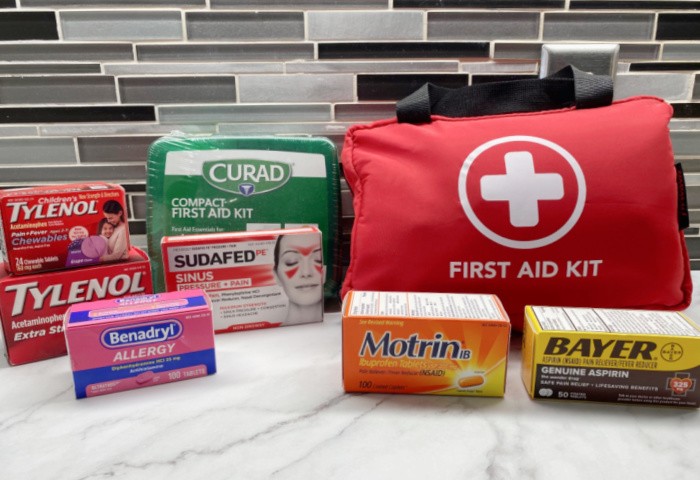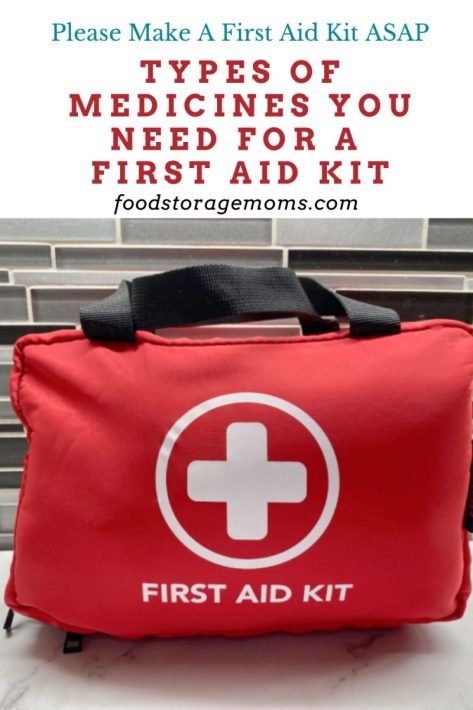
A well-stocked first aid kit is one of the most important things you can do when preparing for emergencies. While bandages, antiseptic ointment, and wipes are commonly found in most kits, many people overlook the importance of including essential medications. While I have many blog posts about what to put in a first aid kit, I want to talk about the types of medicines you need for a first aid kit.

What is a first aid kit?
A first aid kit is a collection of medical supplies and equipment for treating injuries or illnesses. You should keep one on hand for emergencies so that you are prepared in every way possible! A first aid kit requires different types of medicines, and I want to discuss them.
Pain Relief Medications
Pain can be debilitating, especially during emergencies. Including pain relief medications in your first aid kit can provide much-needed relief until professional medical help arrives or becomes available. I like having common pain relief medications in my first aid kits.
- Acetaminophen (Tylenol): This over-the-counter medication effectively reduces pain and fever. It has minimal side effects and is safe for most people, including children and pregnant people.
- Ibuprofen (Advil, Motrin): Ibuprofen is a nonsteroidal anti-inflammatory drug (NSAID) that helps relieve pain, reduce inflammation, and lower fever. It is beneficial for muscle aches, headaches, and minor injuries.
Allergy Medications
Allergic reactions can occur unexpectedly, and having appropriate medications in your first aid kit is vital. Here are two common allergy medications that I keep in my first aid kit: Allergies: What You Need to Know
- Antihistamines: Antihistamines, such as diphenhydramine (Benadryl), help alleviate symptoms of allergic reactions, including itching, swelling, and hives. They can also help with mild cases of motion sickness.
- Epinephrine auto-injector (EpiPen): If you or someone in your family has severe allergies, having an EpiPen in your first aid kit is crucial. This device delivers a dose of epinephrine, which can reverse life-threatening reactions like anaphylaxis until medical help arrives. As far as I know, this one needs a prescription in most U.S. locations.
Digestive Medications
Digestive issues can strike at any time, and being prepared is essential. Consider including the following medications to address common digestive problems:
- Antacids: Antacids like Tums, Pepto-Bismol, Alka Seltser, or Rolaids can quickly relieve heartburn, acid indigestion, and upset stomachs by neutralizing excess stomach acid.
- Anti-diarrheal medication: Medications like loperamide (Imodium) can help manage diarrhea, which can be caused by food poisoning or other gastrointestinal issues.
It’s important to stay properly hydrated. If you get an ailment that causes you to throw up or have diarrhea, you are prone to losing the fluids your body needs to function. Always have some clean and safe water available.
Topical Medications
Aside from oral medications, topical medications are essential in a first aid kit. These medications can help treat various skin conditions and injuries. 35 OTC Medications You Should Store
- Antibiotic ointment: Applying an antibiotic ointment, such as Neosporin, to minor cuts, scrapes, and burns can prevent infection and promote healing.
- Hydrocortisone cream: Hydrocortisone cream can relieve itching, inflammation, and rashes caused by insect bites, poison ivy, or allergic reactions. Having calamine lotion in the kit is a great backup plan when treating areas where itching or a rash are experienced.
- Burn gel: Burn gels or hydrogels help treat minor burns, relieve pain, and provide a protective barrier against infection.
- Sunscreens: We often get sunburned when out, mainly when proper shelter isn’t available in an emergency. Applying sunscreen before outside activities can provide the protection you need. Sunscreens are given an SPF rating based on how they protect you from the sun’s rays. Usually, SPF 30 is recommended for most of us, but my husband uses SPF 70 on his face and ears when golfing.
Additional Medications
Depending on your specific needs, you might consider adding a few other medications to your first aid kit: Tips for Taking Your Medication During a Crisis.
- Aspirin: Aspirin is a pain reliever and can also be used during a heart attack to prevent further blood clotting. However, it should only be given to adults and not to children or teenagers.
- Prescription Medications: If you or someone in your family regularly requires prescription medications, it’s advisable to keep a small supply in your first aid kit, along with clear instructions for use. Personal medications should only be used by those they are prescribed for unless your healthcare professional authorizes use by others.
More Tips
- Emergency Preparedness and First Aid Kit Buckets
- First Aid Kit For Survival
- First Aid Kit Ideas For Your Pets
How often should I check and restock my first aid kit?
It’s important to periodically check and restock your first aid kit to ensure that all items are up to date and in good condition. You should check your kit at least once every six months and replace any expired or used items.
Where can I buy a first aid kit?
First aid kits are widely available and can be purchased from pharmacies, supermarkets, online retailers, and medical supply stores. You can also assemble your first aid kit by buying items and organizing them in a suitable container. First Aid Kits
Besides medicines, what are some other items I should include in my first aid kit?
Some other handy items to consider are:
- Thermometer: If you have a fever, the types of medicines may need to be changed.
- Tweezers: If you have a splinter, bee sting stinger, ticks, or other issues, these little tools can be helpful. Having insect repellant available can minimize some of these challenges.
- Disposable Gloves: Latex gloves are excellent for treating others, so you’re less likely to get sick yourself. This is especially true if you’re working on open wounds and the related blood that’s present.
- Bandages: You should always have a variety of bandages on hand. They come in all shapes and sizes. I like to use butterfly bandages, particularly on more extensive wounds or scrapes.
- Adhesive Tape: Tape is vital to hold sterile gauze pads, cotton balls, or swabs in place. You’ll also need scissors to cut the tape to the proper length.
- Safety Pins: Having these pins of various sizes makes using a sling or splints much easier. If you need to make a tourniquet out of a rag or piece of clothing, you’ll need pins to hold the material in place.
Final Word
Remember, it’s essential to regularly check expiration dates and replace medications in your first aid kit as needed. Consult with a healthcare professional to ensure your medications are appropriate for you and your family members of all ages. What do you think are the types of medicines you need? May God bless this World, Linda
The post Types of Medicines You Need for a First Aid Kit appeared first on Food Storage Moms.
from Food Storage Moms
No comments:
Post a Comment